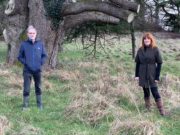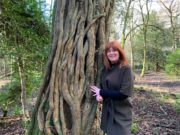Nationwide celebrates National Tree Week
MONDAY 22ND MARCH
On this National Tree Week we have four programmes focusing on efforts to get more trees planted right across the country. Nationwide joins a team in County Wicklow on a planting project and revisits a Westmeath man with a passion and love of trees that began as a child over 70 years ago.
Tomnafinnoge Woods is the last surviving fragment of the great Shillelagh Oak Forest, which once covered the hills and valleys of south Wicklow. The 125 acres that remain today are now a much used and much loved amenity, with stunning walks and trails through this ancient woodland. Nationwide visited the woods to hear their story and to follow the trail of its humble acorns.
Tullynally Estate in County Westmeath has been, like so many other estates, around the country, a place where great trees have been planted and allowed to grow undisturbed. A few years ago, Thomas Packenham who lives at Tullynally wrote a book called, ‘In the Company of Trees’ and our Valerie Waters went to visit him.
TUESDAY 23RD MARCH
Dunsany Estate in Co Meath is the first Irish project recognised by the European Rewilding Network. It was created by Randal Plunkett who is a film-maker and 21st Baron of Dunsany. Bláthnaid Ní Chofaigh visited Dunsany Castle to meet Randal and to see the 750 acres of the estate which he handed back to the wild.
WEDNESDAY 24TH MARCH
Trees are vital to our existence, they produce most of our oxygen and they absorb carbon dioxide. It’s no surprise then that over 2 million people have visited Irish forests during the Pandemic. Recently Helen McInerney visited Avondale House and Forest Park in County Wicklow to hear all about their 8 million euro re-development plan for the historic estate.
‘Stop talking, start planting’ is the catchphrase of the “Easy Treesie” tree planting campaign. Valerie Waters went to Clontarf in Dublin to meet its founder whose ambition is to organise the planting of a million trees across the land by the year 2023.
FRIDAY 26TH MARCH
Despite the fact that Ireland has a low forest cover compared with our European neighbours, we are fortunate enough to have so many woodlands of varying sizes to explore. Valerie Waters met the author of a book detailing Ireland’s forests in the Devil’s Glen in Co Wicklow, which is one of the 340 forests documented in the book.
Anne Cassin visits the campus of University College Cork where their trees have joined some of the leading arboreta in the world after recently being recognised by a prestigious global accreditation programme. UCC now joins The Royal Botanic Gardens in Sydney, The Oxford Botanic Garden at the University of Oxford and the Arboretum de Paris after being accredited globally by ArbNet for the conservation and maintenance of its trees and for the part they play in educational outreach and scientific collaborations of arboreta across the world.
Another Estate that did go under transformation back in the early 1950s was that of Gormanstown in Co. Meath. It became Gormanstown College in 1954 and the new occupants were fortunate to inherit some of the most impressive avenues of trees in that part of the country. Those trees have been recorded on the ‘Tree Register of Ireland’. Valerie Waters met up with a member of the Tree Council of Ireland at Gormanstown to see the type of work that’s involved in surveying many thousands of historical specimens.



